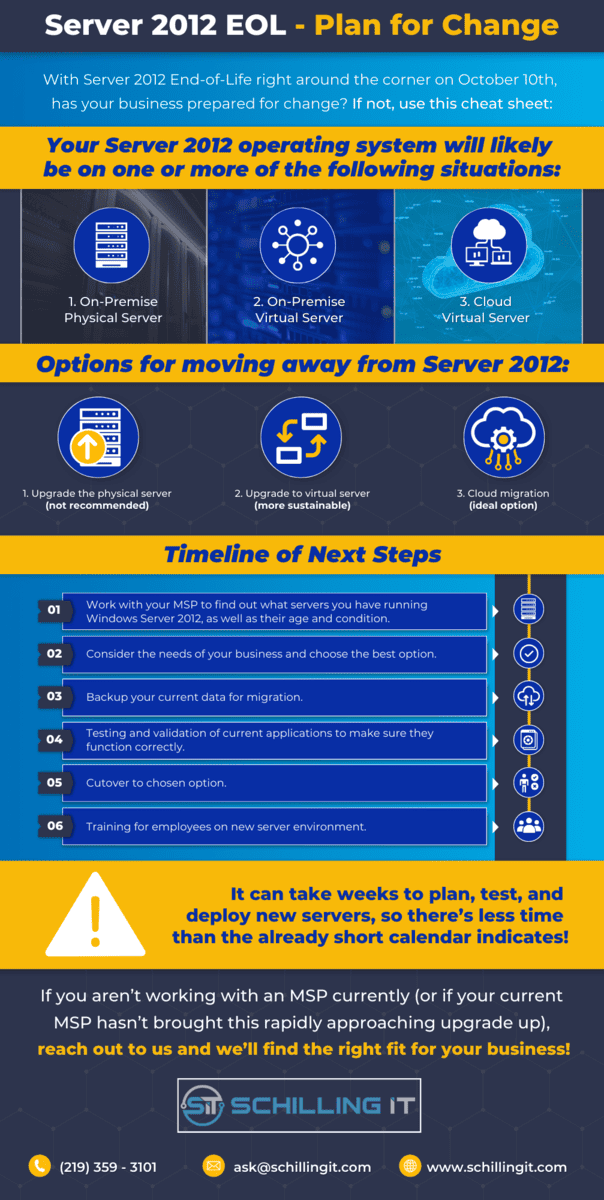We knew it was coming, and the official announcement is finally here.
Microsoft made the significant announcement in May 2023: Windows Server 2012 and Windows Server 2012 R2 will both reach End of Life and End of Support on October 10, 2023.
For businesses with on-premises servers that weren’t bought and configured in the last few years, this announcement means change is coming.
We’re here to help businesses minimize the disruptions that will come with Server 2012 riding off into the sunset. If you’re in that camp, this article is for you.
We’ll walk you through the following:
- Exactly what this announcement is
- The implications of a product like this reaching End-of-Life
- The risks to your business if you don’t take action
- What your options are
Microsoft’s End of Service Announcement: The Details
First up is the announcement itself. In Microsoft’s own words:
“Windows Server 2012 and Windows Server 2012 R2 will end on October 10, 2023. After this date, these products will no longer receive security updates, non-security updates, bug fixes, technical support, or online technical content updates.”
It’s as simple as that: Microsoft isn’t exactly pulling the plug on Windows Server 2012, but it’s reallocating every person who is currently working on the product. After October 10, 2023, that means no more support, updates, or anything.
Technically, there’s one exception or loophole: for customers who cannot upgrade—more on this later—Microsoft does offer something called Extended Security Updates. However, these cost extra, aren’t as good as full support, and essentially mean you’d be throwing money at a dead product. If you suspect you’re one of those edge cases where they might make sense, we’re happy to chat with you individually and either confirm those suspicions or help you map out a better course forward.
What This Announcement Means for the Future of Windows Server 2012
So, what are the implications of an End of Support / End-of-Life announcement like this?
Security
First, security: every software and OS product has flaws. Some of these will, once discovered, allow the bad guys to do bad things within the software, like steal data or snoop on network activity.
Security updates are the way that software and OS makers fight back: once these vulnerabilities and exploits are discovered, software makers fix them and release those fixes in the form of security updates.
(Side note: this is why we’re so hawkish on installing all those security updates! They are literally keeping you safe from known digital attacks.)
When an OS reaches EOL, the software developer stops fixing those flaws. That means any vulnerability discovered after October 10 will remain open and vulnerable for the rest of time.
Stability
Have you ever noticed that hardware and software both seem to perform worse over time? The hardware side makes sense: newer, more demanding features come along, and your older hardware can’t do them like new hardware can. But why does the same software, running on the same machine, gradually grow more sluggish or unstable?
The answers are complicated, but the takeaway isn’t: as computing environments evolve, software must evolve to keep up and stay stable. That’s what non-security software updates do, more or less.
When a product reaches End-of-Life, it tends to become progressively less stable — because no one is making the needed adjustments to keep the product running well under current conditions.
Ticking Clock on Future-proofing
The last implication we’ll cover is a little hard to name, but it’s easy to understand.
Let’s say you’re in the market for a new iPhone. If you’re currently using an iPhone that’s just a generation or two old, moving everything from your old phone to the new one happens almost like magic.
But imagine instead that your shiny new iPhone went kaput, and the only “backup” phone you still have in the drawer is a 10-year-old iPhone 4.
If you try to load a backup of your new phone onto that old one, it’s not going to go well for you. It’s just too old: Apple isn’t supporting 10-year-old iPhones anymore, and you definitely can’t load the latest version of iOS onto one.
What does this have to do with Server 2012? As long as Microsoft is actively supporting Server 2012, it’s also actively supporting future-proofing. Right now, you can find guides on migrating Server 2012 to a half dozen other Microsoft products.
But once support ends, the clock starts ticking on future-proofing. Wait too long, and it will be like trying to make that ancient iPhone work in 2023.
The Risks to Your Business if You Don’t Take Action
Hopefully after the last section, we’ve convinced you that Server 2012 EOL is a big deal, but let’s talk about the risks your business faces if you don’t move away from Server 2012.
Security and Stability
Just like we described above, once Server 2012 reaches End of Support, any vulnerabilities that are discovered will remain unpatched. The same goes for stability issues in the OS.
Microsoft is essentially saying, “Upgrade, or you’re on your own.” If you don’t, you’ll be vulnerable to attacks and to instability in increasingly severe ways.
Missing Capabilities
This one’s simple: newer operating systems can do things older ones can’t. Sticking with the old one means you’re missing out on capabilities that your competitors are enjoying.
Migration Woes
Remember what we said about future-proofing: if you don’t upgrade now, you may find that migrating to something new is much harder later (thanks to that lack of support).
Your Options for Moving Forward
Since change is coming, let’s talk about your options for moving your business forward.

Server 2012 EOL – Plan for Change
The first, the simplest option is just upgrading to Server 2022. Unfortunately, many of the servers running Server 2012 are just too old to do so.
The second option is upgrading those old servers. When you replace a 2010-era server with its modern equivalent, the new one will come preloaded with Server 2022. It’s just a matter of moving items over, and you’re back in business.
The third option, you could take this opportunity to move to a fully cloud environment and get rid of that on-premises server entirely. This is the most invasive option, but also the one that delivers the most value to your business.
With any of these options, you’ll gain the benefits of a newer operating system. With options 2 and 3, you’ll gain more processing power and storage capabilities, too.
These are the most common solutions for businesses still running Microsoft Windows Server 2012 or 2012 R2, but we know every case has its own unique considerations.
If you’d benefit from a professional consultation on the right path forward for your business, we’d love to help! Reach out now to get started.
Fill in our contact form and our team will reach out!
"*" indicates required fields

